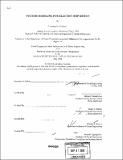Systems modeling for electric ship design
Author(s)
Soultatis, Charalambos
DownloadFull printable version (13.42Mb)
Other Contributors
Massachusetts Institute of Technology. Dept. of Ocean Engineering.
Advisor
Michael Triantafyllou and Henry S. Marcus.
Terms of use
Metadata
Show full item recordAbstract
Diesel and gas turbine electric ship propulsion are of current interest for several types of vessels that are important for commercial shipping and for the next generation of war ships. During the design process of a platform, a choice has to be made between two different fundamental concepts regarding propulsion; a conventional arrangement, and a diesel or gas turbine electric propulsion. For both concepts, the electrical installation is present and the demand for additional electric energy becomes a dominant parameter. In both cases, the selection of the prime mover significantly influences the effectiveness of the design. In this thesis, the simulation modeling of a complete propulsion system will be attempted, with overall emphasis on the prime movers. In the first part a diesel engine is considered. The time delay between changing a set point for the revolutions of the engine and the change of the real revolutions is often modeled as a first order system. However, this modeling is too simple to describe the real behavior of the diesel engine. More complex models exist, but in general they are too complex, describing the full thermodynamic behavior of diesels. (cont.) So there is a need for a model that is more advanced than a first order system and less complex than complete thermodynamic models. Such a model has been derived, based on the Seiliger (thermodynamic) process. The results of the model show that the diesel engine behaves like a second order system when operating in the governor area and more like a first order system in the constant torque (overload) area. The simulation model of a diesel engine can be regarded as an explanation of the real engine operation, which combines the mathematical relationship between the relative components and can be used to simulate dynamic loading of the diesel engine. In the second part, a development of a nonlinear gas turbine model for loop- shaping control purposes is presented. The nonlinear dynamic equations of the gas turbine are based on first engineering principles. In order to complete the model, constitutive algebraic equations are also needed. These equations describe the static behavior of the gas turbine at various operating points. (cont.) The complete, substituted nonlinear model is presented along with its model verification results based on a simulator and measured data. A mathematical description for the electric part of the propulsion and energy generation system with respect to numbers of components such as generators and thruster drives is attempted. Other electrical loads may be represented with an aggregate load. Based on the control functions focus on power production, advanced dynamic models shall be used for the generators and simplified static models shall be used for thruster drives and other loads. The final model shall be in a state-space vector form, suitable for control design. As a conclusion, a reliability analysis on the decision for the electric propulsion system is utilized based on market data, speed and electric energy requirements studies. The purpose of this study is to justify the employment of innovative and efficient electric propulsion systems for the future needs of the commercial and naval ship industries.
Description
Thesis (Nav. E. and S.M.)--Massachusetts Institute of Technology, Dept. of Ocean Engineering, 2004. Leaf 185 blank. Includes bibliographical references (leaves 172-174).
Date issued
2004Department
Massachusetts Institute of Technology. Department of Ocean EngineeringPublisher
Massachusetts Institute of Technology
Keywords
Ocean Engineering.